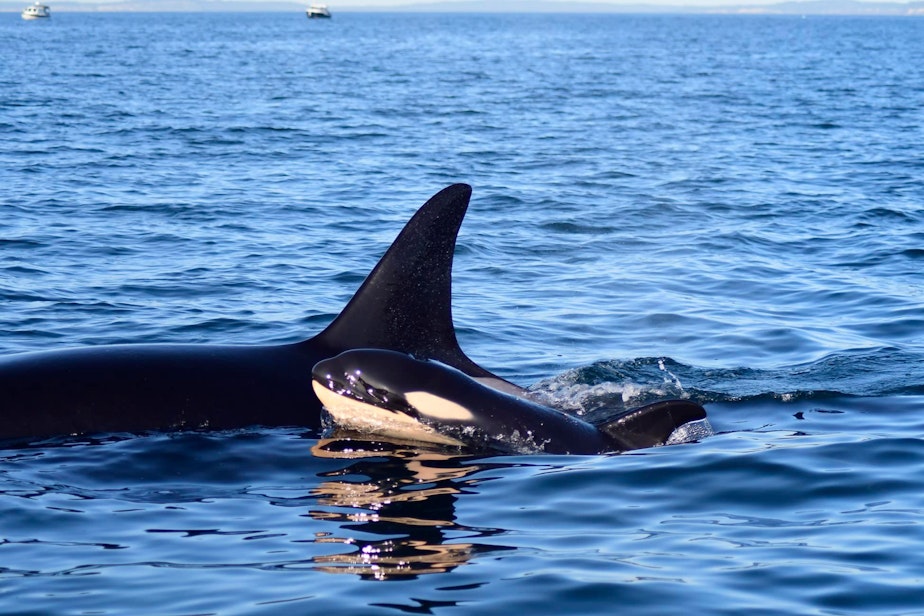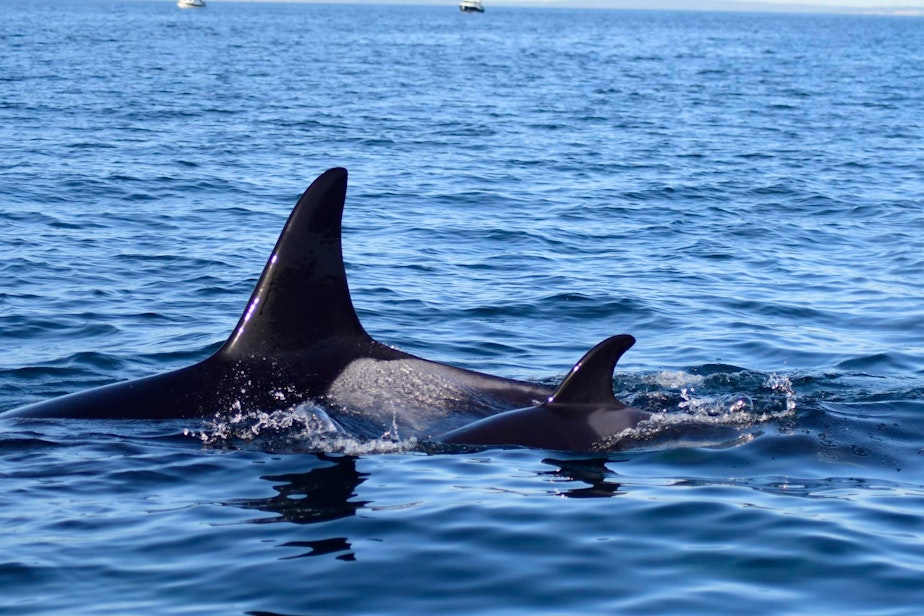Newborn orca spotted near Seattle off Bainbridge Island

Beachgoers and whale researchers were excited to spot a newborn calf swimming with the Northwest’s endangered orcas on Tuesday near Seattle.
“Oh my gosh,” schoolteacher Neil Davis said, standing on the beach at Fay Bainbridge Park on Bainbridge Island as a group of southern resident killer whales sliced through the glassy water just offshore.
With the snow-covered Cascades on the horizon, the afternoon was quiet except for bursts of air from the marine mammals’ blowholes and the oohs, wows, and other excited exclamations bursting from the mammals standing on shore.
Davis had alerted his husband’s family and a friend’s family that the orcas were nearby. About 15 people gathered on the beach to watch the orca families swim quietly by.
“Look at ‘em!” one beachgoer said.
“They’re really close, huh? You don’t need binoculars for that!” another said.
Sponsored
“Oh! The baby!” Davis said as the smallest of fins sliced through the water.
On Wednesday, the Center for Whale Research confirmed that the baby orca is the newest member of J pod, one of the Northwest’s three family groups of the endangered killer whales known as the southern residents.
“I spent quite a bit of time during the pandemic watching whales from shore. But this is the closest I’ve seen them,” Davis said in a text message.
Whale researchers Maya Sears and Mark Sears had seen the 25 members of J pod on the afternoon of Dec. 23, but no baby, meaning this 26th member was probably born on Christmas Eve or Christmas Day.
The father-daughter team was out on the water again in their small research boat on Wednesday, hoping to scoop up floating fecal samples from the endangered orcas.
RELATED: It's getting quieter in Puget Sound and easier for orcas to find dinner
Sponsored
“When calves are really young, they have a peach-ish tinge to the white parts of their body,” Maya Sears said. “We saw a tiny little fin that was just more peachy.”
The researchers said the new baby orca appears to be in good shape.
“It was quite active, attempting to tail slap, and once got a good tail slap in,” Mark Sears said.
“She was still trying to figure out this whole ‘life’ thing,” Maya Sears said.
The baby’s sex and its mother remain unknown. It was swimming in the midst of a large group of adult females, though it often surfaced closest to the whale known as J40.

Sponsored
“The calf was mostly coming up with J40, mostly synchronizing breathings with her,” Maya Sears said.
“I was really excited to see J40 was the [likely] mom because, coincidentally, 19 years ago, almost to the day, we were the first ones to spot J40,” she said.
RELATED: What are that new baby orca’s chances of surviving?
Mark Sears has been researching orcas since the 1970s, with his daughter joining him more recently. She calls herself a "professional whale pooper scooper."
“She’s the real identity expert,” Mark Sears said. “I’m the one who positions the boat so she can do the work and do the heavy lifting.”
“It’s a real privilege,” he said. “I can’t say how happy I am to work with an adult daughter in this capacity.”
Sponsored
Among the fish-eating orcas, many newborns don’t survive past their first birthday due to pollutants in their mothers’ milk and a lack of salmon to eat.
Orca mothers offload long-lasting, toxic pollutants like PCBs in their flesh to their young, especially their firstborn, when they nurse them.
“We hope to see lots more of this calf in the coming weeks and months, and that both the calf and its mother will be able to thrive,” an announcement from the Center for Whale Research states.
If this baby whale survives, it will bring the estimated endangered orca population up to 75 animals.
If J40 is this baby’s mother, that gives hope that another pregnant member of J pod, J46, might give birth soon.




